Rubber molding is a versatile manufacturing process that can produce a wide range of products, from simple seals and gaskets to complex automotive parts. It is a cost-effective method that offers high precision and accuracy, making it a popular choice for many industries.
There are three main types of rubber molding: injection, compression, and transfer molding. Each method has its benefits and ideal applications. Therefore, understanding them will help you choose the right one for your project.
In the following sections, we will explore the different types of rubber molding in more detail. You’ll learn the different samples of injection molded rubber parts and their applications. We’ll also give you tips on choosing the most suitable technique for your needs.
What’s Rubber Molding?
Rubber molding is a key manufacturing process that turns uncured rubber into durable, versatile parts tailored to diverse applications. This technique is integral to producing components with precision, capable of forming complex shapes and designs with outstanding durability. Its efficiency in mass production minimizes waste and ensures consistent quality, making it a cost-effective option for industries. The inherent resistance of rubber to harsh conditions, including extreme temperatures and corrosion, further elevates its value in demanding applications.
Moreover, the adaptability of rubber molding allows for extensive customization in rubber compounds, meeting specific performance requirements. This aspect is crucial in sectors where precision and material resilience are paramount, such as automotive and healthcare. As a result, rubber molding stands out as an indispensable process in the production landscape, providing robust, reliable, and tailored solutions that significantly enhance product performance and longevity.
How to Create Rubber Components
Suppose you are looking to produce a rubber product in large quantities. In that case, rubber molding is an efficient and cost-effective way to do it. Here are the basic steps involved:
Design the Mold
The first step is designing the mold. The mold will determine the shape and size of the end product. It is typically made of metal and can be designed to produce a single part or multiple parts at once. The design of the mold will depend on the product’s intended use, and it may include features such as ridges, holes, or other shapes.
When designing it, there are several considerations that you need to take into account.
- Material Selection: Choose a material suitable for the type of rubber you will be molding. The material should be able to withstand the high temperatures and pressures that are involved in the molding process.
- Part and Mold Design: The part’s design influences both mold construction and the molding process. Ensure compatibility with the selected rubber and molding technique. The mold should be designed to yield the desired part dimensions and shape.
- Venting: Venting is the process of allowing air to escape from the mold during the molding process. If air does not escape, it can cause defects in the product. Make sure your mold is adequately vented to prevent these defects from occurring.
- Cooling: Inappropriately cooled parts can end up with defects. So, you must consider cooling when creating the mold.
Create the Mold
After designing, create the mold via CNC machining, 3D printing, or casting, depending on complexity and detail. Clean and prepare the mold for fabrication, which involves multiple steps to produce high-quality rubber molds.
- Creating the Mold Core and Cavity: Create the mold core and cavity from materials like steel or aluminum for the internal and external shaping of the rubber part.
- Machining the Mold: Precision machine the mold using CNC to meet exact specifications.
- Polishing the Mold: Polish the mold to eliminate any rough edges or imperfections, ensuring a smooth surface for the rubber part.
- Assembling the Mold: Assemble all mold parts, including ejector pins and cooling channels, to finalize the mold for use.
Vulcanization in Rubber Molding
Vulcanization chemically bonds rubber molecules through heat and pressure, enhancing durability and stability. In this process, the rubber cross-links in a mold, creating a robust three-dimensional molecular network.
Various methods can be employed, including compression, transfer, and injection molding. Compression suits large, flat, or uniquely shaped parts, transfer molding is optimal for small, intricate components, and injection molding excels in creating complex shapes with tight tolerances. Each technique ensures the rubber achieves its characteristic strength and resilience, tailored to specific manufacturing needs.
Different Types of Rubber Molding Process
Rubber molding is a diverse manufacturing method with lots of variants. Each type has its own specialized production procedure, advantages, and disadvantages. We will present a detailed summary of the most well-known ones: injection molding, compression molding, and transfer molding.
#1 Rubber Injection Molding
Rubber injection molding is very similar to the more well-known plastic injection molding process. It starts with the uncured rubber strips that go into the machine via a hopper. Once through the hopper, it enters the screw chamber, where it is heated and compressed by external heaters and friction from the movement of the screw.
Near the end of the screw, the rubber has heated to a very fluidic state. It is fed into the mold at high pressure and it fills up the cavity built inside the rubber mold. Due to its flow properties, the rubber material fills every nook and cranny of the cavity.
The mold then gradually cools down so the rubber solidifies. Finally, the mold opens to eject the end product, after which it is ready for the next cycle.
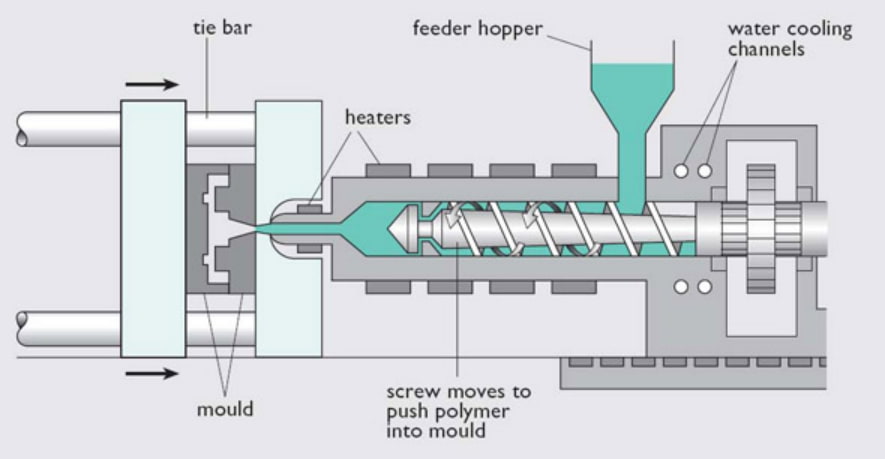
Advantages of Rubber Injection Molding
- High Accuracy: The application of pressurized rubber injection along with the good flow properties of rubber allows the raw material to fill up the mold and reach every corner. The result is thus very precise.
- Complex Geometry: This method can manufacture designs with special features like holes, curvature, and sharp contours. The mold cavity design has a lot of flexibility and it can accommodate elements like cores to allow for complex features in the rubber part.
- High Mechanical Strength: Due to pressure and ample curing time, the parts have high strength and durability.
- No Finishing: Injection molded rubber products have fewer defects or leftover material that needs after it come out from the mold. Except for a small parting line and gate vestige, the output is a near-net shape.
- Quick Process: Modern control technologies ensure precise control of heat and pressure in injection molding machines. Optimization of these processes can lead to short curing cycles, giving a major advantage in terms of time.
- Economies of Scale: Apart from initial tooling costs, the molding cost per item is quite low. If mass production is the goal, it is perhaps the best way to maximize profitability.
Disadvantages of Rubber Injection Molding
- Material Limitations: One downside to rubber injection molding is that it requires good flow properties. Not all rubbers have the necessary properties so the raw material options are limited to flexible, liquid-like rubbers like silicone rubber, polyurethane, nitrile rubber, etc. However, most rubber materials are capable of injection molding.
- High Initial Costs: The tooling cost and the molding machine are expensive. Hence, it is sometimes not financially viable for low volume injection molding.
#2 Rubber Compression Molding
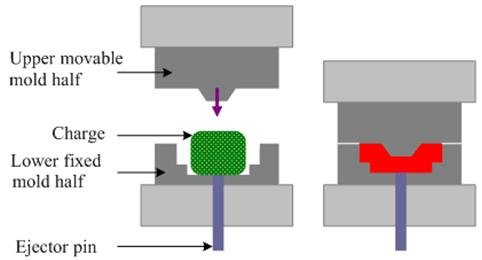
Compression molding is similar to injection molding in the respect that it also utilizes heat and pressure. However, the application of heat and pressure are quite different, explained as follows.
The mold has two halves, each carrying a portion of the cavity. At first, the uncured raw material, known as the charge, is pre-heated and placed in the lower half. The mold sections are also heated beforehand.
Once the operator is content with the material’s placement, the plug (the movable half of the mold), lowers down into the fixed mold. Due to the pressure from the plug, the charge takes the mold cavity shape. The mold applies heat to cure the rubber in its new shape. Finally, the molded rubber comes out as the final product.
More: You can learn some differences between compression and injection molding here.
Advantages of Rubber Compression Molding
- Low Cost: The tooling is not very expensive owing to its simple design and the production costs also decrease as the volume of production increases.
- Low Maintenance: The simple design and absence of complex spruce networks mean that cleaning and repairing/polishing the mold is easy and inexpensive. Also, it takes less time to maintain than more complex mold designs.
- Variety of Materials: Since compression molding does not rely on material flow, it can handle a wide variety of rubbers.
- No Gate Vestige: The mold does not have a gate so the final product does not have the gate vestige left behind. Also, this improves the product’s aesthetics and decreases the finishing cost.
Disadvantages of Rubber Compression Molding
- Dimensional Tolerance: Manufacturing accuracy is good in the case of compression molding but not as high as injection molding. There can be slight deviations from the mold cavity in places like high curvatures and pockets.
- Finishing: While there may be no gate vestige, finishing operations are still necessary to remove flashes and parting lines. Grinding or cutting takes time and money.
#3 Rubber Transfer Molding
Transfer molding utilizes a distinct rubber mold design. The die mold has two halves like any other mold but the upper half has an additional open-ended cavity known as the pot. A spruce network connects the pot and the main cavity. The preform is placed into this pot and ‘transferred’ into the cavity by a plunger through high pressure and heat.
The raw material then cures and solidifies. Finally, the mold ejects the final product once it has cooled down and vulcanized.
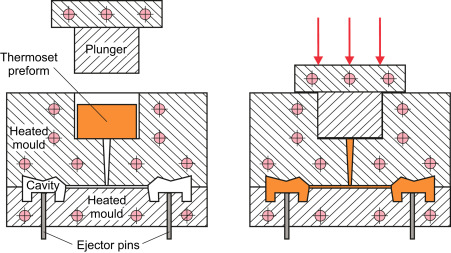
Advantages of Rubber Transfer Molding
- Tight Tolerance: This technique can provide rubber molded parts with dimensional tolerance and is very suitable for manufacturing accurate part geometries.
- Metal Bonding: Rubber-to-metal bonding is a strong point of transfer molding. It is a convenient method to manufacture parts like combined metal-rubber mounts.
- Large Parts: The mold design can include large cavities with ease.
- High Cavity Count: The pre-form is a very simple shape and does not require much preparation. As a result, the same preform is reusable for many cycles without much hassle, saving time and effort.
Disadvantages of Rubber Transfer Molding
- High Tooling Cost: The mold has additional features like the pot and spruce. These make it more complex to design and manufacture. But the complexity also adds cost to the initial setup.
- Finishing: Deflashing is always necessary when using transfer molding due to the spruce.
- High Cycle Time: Unlike other processes, the curing time is high for this technique, which is an important consideration in many processes.
Samples of Rubber Molded Parts
Rubber molded parts are vital across industries for sealing, vibration dampening, and shock absorption, significantly enhancing product functionality and durability. Common types include:
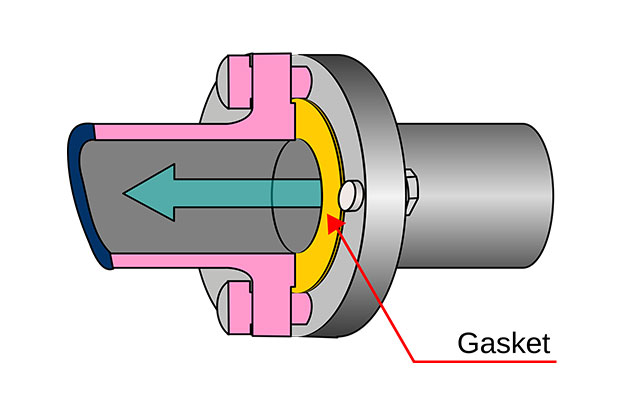
Rubber O-Rings
Rubber O-rings are circular, doughnut-shaped components meticulously crafted from flexible rubber materials. These precision-engineered rings exhibit a near-perfect circular cross-section, ensuring uniform compression.
The circular design of O-rings allows them to form a tight seal when compressed between two surfaces. They are used to seal fluids, gases, and other materials in a wide range of applications. This sealing ability makes them indispensable in hydraulic systems, engines, and plumbing. They prevent leaks and ensure the efficiency of various mechanical operations. They are also useful in pneumatic systems and automotive engines.
Rubber Seals
Rubber seals are designed to prevent the leakage of fluids or gases between two surfaces. They come in various shapes and sizes, including rectangular, circular, and square. These flexible components act as guardians, forming a secure barrier against the infiltration of liquids or gases.
They are useful in a wide range of applications. In the automotive industry, they are employed in engines, transmissions, and doors to prevent fluid and gas leakage. They are also critical for maintaining airtight connections in aircraft components. Product designers also use them in machinery and equipment to ensure structural integrity and prevent leaks.
Rubber Gaskets
These thin, flat pieces are engineered to provide cushioning and sealing between two surfaces. Their adaptability sets them apart, allowing customization for specific shapes and sizes.
Gaskets are crucial in preventing leaks in pumps, compressors, and engines. These components are essential for sealing joints in various automotive applications. They also create a secure and leak-free seal in industrial pipe connections.
Rubber Tubing
Rubber tubing, elastic and durable, adapts well to various fluid transfer applications. While mainly cylindrical, it also appears in round, square, or rectangular forms. It serves a critical role in medical devices like IV lines and catheters for precise fluid transfer and is essential in factories for moving chemicals, liquids, and gases, reflecting its wide utility in diverse operational processes.
Rubber Mounts
These are components used to isolate vibration and reduce noise in a wide range of applications. They come in various shapes and sizes, including cylindrical, conical, and rectangular. Their ability to absorb shocks and vibrations enhances stability, reduces noise, and extends the lifespan of machinery.
Mounts help provide stability in heavy equipment, reducing vibrations during operation. They also help dampen vibrations in electronic devices, ensuring optimal performance. Mounts enhance vehicle components’ stability, reducing noise and improving ride comfort.
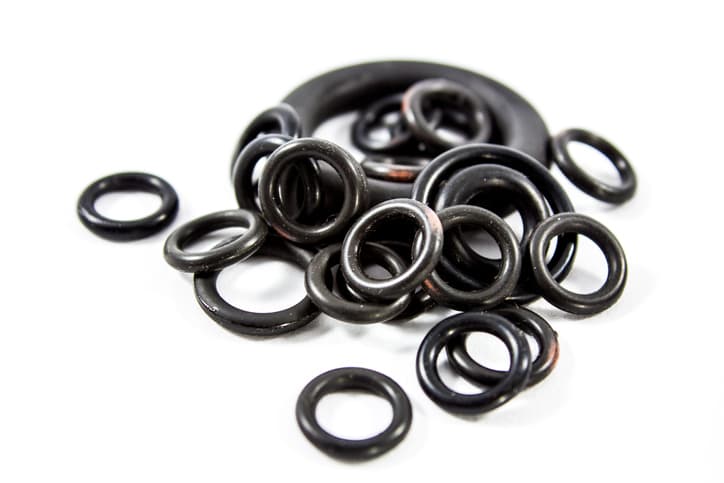
Rubber Bumpers
Rubber bumpers, typically cylindrical or hemispherical in shape, serve as protective buffers designed to absorb impact energy. Their resilient nature makes them effective in preventing damage to delicate components.
Bumpers protect vehicle surfaces from scratches and damage during collisions. They are used to shield sensitive electronic equipment from impact and vibrations. Some furniture applications employ them to prevent damage and scuffing.
Rubber Bushings
Rubber bushings are cylindrical components engineered to reduce friction between moving parts in machinery. This reduction in friction contributes to improved performance and durability. Bushings play a vital role in reducing friction in automotive suspension systems. Their applications in rotating equipment help minimize wear and noise. Likewise, they enhance the performance of mechanical components by reducing friction.
Rubber Diaphragms
Rubber diaphragms, thin and flexible, actively respond to pressure changes, controlling fluid flow in pumps, valves, and control systems. They transfer pressure and motion between surfaces and vary in shapes, such as circular or rectangular. In pneumatic applications, these diaphragms manage air and gas flow. Engineers use them in pumps and valves for precise fluid control in medical equipment and to regulate fluid flow in automated systems.
Rubber Grommets
These are donut-shaped with a central hole. Rubber grommets serve as protective and organizational tools for managing cables. They ensure a neat arrangement to protect wires and cables from damage caused by sharp edges.
Grommets are useful in electrical wiring to protect wires from abrasion during electrical installations. They also ensure a tidy arrangement of cables in many electronic equipment. Automotive manufacturers also use them to organize and protect wiring in vehicles.
Rubber Isolators
Rubber isolators often resemble cylindrical pads. They help isolate vibration and reduce noise in various applications. They find applications in machinery, HVAC systems, and electronic equipment, providing stability and reducing noise.
Isolators reduce vibrations in heating, ventilation, and air conditioning units. They are essential for stabilizing equipment and preventing structural damage. Manufacturers also use them to dampen vibrations in sensitive electronic devices.
Rubber Suction Cups
Rubber suction cups create a vacuum seal between a surface and an object with their concave shape, adhering through suction for a reliable grip. Industries widely use them in manufacturing, packaging, and robotics. In automated production lines, workers use suction cups to pick and place items. They secure packaging materials during packing processes and serve as critical components in robotic arms for handling materials.
RapidDirect excels in manufacturing prime-quality rubber products. Our top-of-the-line injection molding equipment and seasoned experts are highly experienced in providing impeccable R&D and manufacturing services to our esteemed clientele.
Rubber Material Options for Rubber Molding
Rubber materials are known for their unique flexibility, elasticity, and thermal insulation, essential for applications requiring impact absorption and temperature resistance. They also resist a wide range of chemicals, making them versatile in manufacturing, particularly in plastic rubber molding. This section delves into the various types of rubber used in these processes.
Natural Rubber (NR)
Natural rubber (NR) boasts exceptional elasticity and tensile strength from its unique polymer structure. Its durable nature and resistance to water, acids, and alkalis make it ideal for demanding applications in the automotive, aerospace, and industrial sectors. Industries widely use NR in conveyor belts for its resilience and abrasion resistance, while its elasticity benefits seals and gaskets, creating effective barriers across various settings. As a renewable resource from rubber trees, NR remains indispensable in manufacturing.
Styrene-Butadiene Rubber (SBR)
SBR is a synthetic alternative to natural rubber, offering excellent abrasion resistance, aging stability, and cost-effectiveness. Its styrene and butadiene structure endows it with resistance to heat, ozone, and chemicals, ideal for harsh environments. SBR’s versatility shines in automotive parts and industrial hoses, where it ensures durability and reliable performance in various applications.
Neoprene Rubber
Neoprene rubber, known for its resistance to oil, chemicals, and abrasion, stands out for its weather and flame retardancy. It’s durable and flexible across temperatures, making it ideal for automotive hoses, gaskets, and seals in demanding conditions. Its resistance to ozone and sunlight suits outdoor applications, while its electrical insulation properties widen its industrial utility. Neoprene serves various industries with its robustness and versatility.
Nitrile Rubber (NBR)
Manufacturers choose this rubber material because of its excellent resistance to oil, fuel, and chemicals. NBR is also resistant to heat and ozone, making it suitable for use in harsh environments. O-rings and seals in automotive settings benefit from NBR’s oil resistance and resilience, ensuring reliable performance over time. Its application extends to oil-resistant hoses, providing a secure and durable solution for fluid transportation. In fuel handling components, NBR’s chemical resistance safeguards against degradation. This maintains the integrity of the components.
Butyl (IIR)
Butyl rubber, or IIR, excels in air retention and gas impermeability, making it perfect for automotive tire inner tubes, air springs, and fuel hoses due to its heat, ozone, and weather resistance. Its low gas and moisture permeability suits applications requiring airtight seals. Widely used in vibration mounts for its durability and environmental resistance, Butyl also plays a crucial role in pharmaceutical stoppers and construction sealants, ensuring waterproofing and airtight sealing.
Fluoroelastomer Rubber
Fluoroelastomer rubber, a fluorocarbon-based polymer, boasts exceptional chemical and heat resistance, making it ideal for the chemical, oil, and gas industries. Its resilience to oils, fuels, acids, and solvents suits extreme conditions, commonly used in aerospace seals, chemical equipment, and automotive O-rings. It provides reliable seals and withstands diverse environments, ensuring stability and protection in demanding applications.
Silicone Rubber
Silicone rubber, known for its heat resistance, flexibility, and biocompatibility, is essential in various sectors. It resists water, UV, and ozone, making it ideal for electrical insulators, seals, and gaskets. Its low-temperature flexibility suits medical devices, while its non-toxic nature benefits kitchenware. Automotive components use it for its heat resistance and flexibility, and it’s a reliable insulator in electronics, enhancing safety and durability across applications.
Considerations for Choosing Suitable Rubber Molding Material
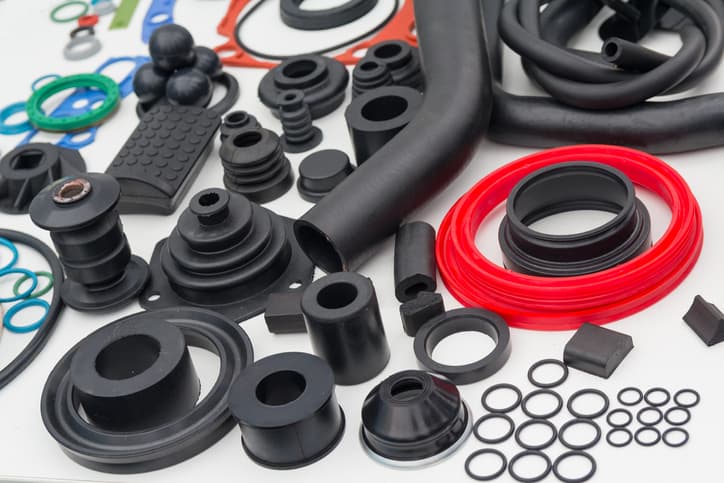
When choosing the right rubber molding process for your product, there are a few considerations to remember.
What Is the Temperature Your Product Needs to Withstand?
Different rubber compounds exhibit varying tolerance levels to heat and cold. Understanding the temperature extremes your product will encounter allows you to select a material that can withstand these conditions.
Heat-resistant rubber compounds like Silicone may be ideal for applications involving high temperatures. Such applications include automotive components or industrial machinery. Conversely, rubber compounds with low-temperature flexibility are best for products exposed to colder environments. They ensure that the material remains pliable and effective even in freezing conditions.
How Much Environmental Stress Your Product Will Be Exposed To?
Environmental stress includes exposure to sunlight, chemicals, and moisture. These stresses can significantly impact the performance of the product. Assess the specific environmental conditions your product will face. This will help you choose a molding material that can resist degradation and maintain its integrity over time.
Use weather-resistant rubber compounds for outdoor applications or products exposed to UV radiation. They provide excellent protection against sunlight and ozone. Chemical-resistant rubber compounds are essential for products in industrial settings where exposure to corrosive substances is common. They ensure longevity and reliability under challenging conditions.
How Much Physical Forces Will Your Product Be Subjected To?
Consider the degree of compression, tension, and impact your product will face, particularly if it’s used in demanding settings like constant motion or heavy machinery. Selecting a rubber material with the right properties is crucial for durability. Opt for high-tensile strength materials like Natural Rubber or Neoprene for robust applications. Moreover, factors in abrasion resistance mitigate wear and tear and extend the product’s life.
What’s Your Budget?
The budget is an important factor in deciding upon a rubber material. Some cost more with added advantages, while some are cheap but slightly compromise on quality. For example, EPDM and Silicone are two rubber materials with similar properties and applications. Generally, however, EPDM is slightly less costly than Silicone but also requires more frequent replacements, even when used in similar environments. So, there is always a trade-off between cost and quality.
RapidDirect: The Best Partner of Custom Rubber Molding
A huge advantage of the processes of making rubber parts is their customizability. With the discussed technologies, engineers enjoy the liberty of designing rubber parts that are unique and best fitted to their products. This enhances user experience, promotes creativity, and boosts your sales.
With custom rubber molded parts, there is an opportunity to develop your brand identity with products that target your users.
When it comes to customized rubber molding, RapidDirect leads the industry with its cutting-edge compression molding and injection molding services. Our precision rubber molding equipment is capable of achieving superior manufacturing tolerances and unparalleled rubber curing.
We boast a talented team of creative and technical professionals, who have spent years creating custom molded parts with complex designs for our valuable clients. We specialize in providing solutions specific to your needs. Based on your application, we conduct directed research and select the most well-suited rubber material from a pool of high-quality candidates.
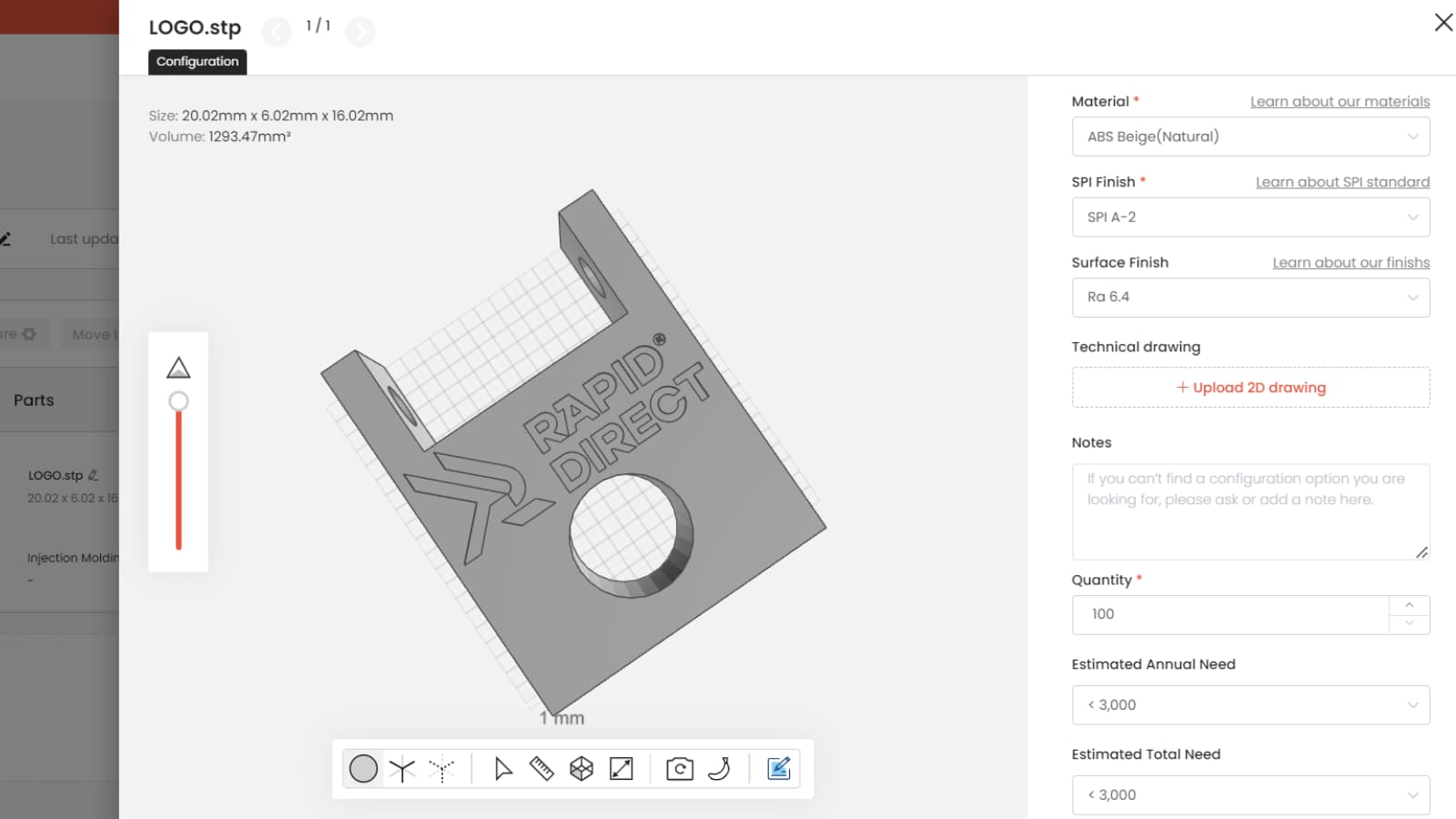
Our online quoting platform makes communication with our experts very convenient. Just upload your product designs via our online platform to get quotations and get a Design For Manufacturing Analysis, completely on the house!
Conclusion
While the debate of which rubber molding method and rubber materials are the best continues on various forums, what it boils down to is how well you use these tools.
Rubber production is a highly diversified field with innovations and ideas frequently improving the market. As discussed throughout this article, each technique has its pros and cons. So does every material. However, experience and creativity are irreplaceable!
When it comes to molding rubber parts, design sense, and manufacturing expertise are what make the true difference. To get professional consultancy from our team, you are welcome to contact us.


